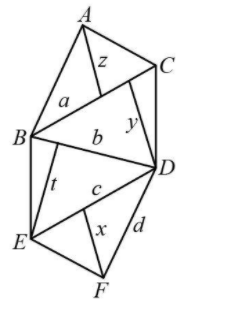
What is the area of the plot shown in the figure?

A) $\dfrac{1}{2}\left( {az + by + ct + dx} \right)$
B) $\dfrac{1}{2}\left( {bt + cx + ay + az} \right)$
C) $\dfrac{1}{2}\left( {cx + bt + by + az} \right)$
D) $\dfrac{1}{2}\left( {d + t} \right)\left( {c + x} \right) + \dfrac{1}{2}\left( {a + b} \right)\left( {y + z} \right)$

Answer
555.3k+ views
Hint: The given figure consists of four triangles. The formula to find the area of the triangle when its base and height is given is: $\dfrac{1}{2}bh$ where $b$ stands for base and $h$ stands for height.
Complete step-by-step solution:
The total area of figure $ABCDEF$ is given as the sum of the area of the $\Delta ABC$,$\Delta BCD$,$\Delta BED$and$\Delta EFD$,that is given as:
$Ar\left( {ABCDEF} \right) = Ar\left( {\Delta ABC} \right) + Ar\left( {\Delta BCD} \right) + Ar\left( {\Delta BED} \right) + Ar\left( {\Delta EFD} \right)$ ……(i)
In triangle $\Delta ABC$,
Base of the triangle is $a$.
Height of the triangle is $z$.
Hence, area of the triangle is given by,
$
\Delta ABC = \dfrac{1}{2}bh\\
= \dfrac{1}{2} \times a \times z……(ii)
$
In triangle $\Delta BCD$,
Base of the triangle is $a$.
Height of the triangle is $y$.
Hence, area of the triangle is given by,
$
\Delta BCD = \dfrac{1}{2}bh\\
= \dfrac{1}{2} \times a \times y……(iii)
$
In triangle $\Delta BED$,
Base of the triangle is$b$ .
Height of the triangle is$t$.
Hence, area of the triangle is given by,
$
\Delta BED = \dfrac{1}{2}bh\\
= \dfrac{1}{2} \times b \times t……(iv)
$
In triangle $\Delta EFD$,
Base of the triangle is $c$.
Height of the triangle is $x$.
Hence, area of the triangle is given by,
$
\Delta EFD = \dfrac{1}{2}bh\\
= \dfrac{1}{2} \times c \times x ……(v)
$
Substitute the values of areas of the triangles $\Delta ABC$,$\Delta BCD$,$\Delta BED$and$\Delta EFD$from equation (ii), (iii), (iv) and (v) respectively in equation (i).
$
Ar\left( {ABCDEF} \right) = \dfrac{1}{2}az + \dfrac{1}{2}ay + \dfrac{1}{2}bt + \dfrac{1}{2}cx\\
= \dfrac{1}{2}\left( {az + ay + bt + cx} \right)
$
Therefore, option (B) is the correct answer.
Note: In such types of problems, make sure to find the correct value of base and height for the corresponding triangles to find the total area of the figure. The solution is totally based on the formula of area of the triangle.
Complete step-by-step solution:
The total area of figure $ABCDEF$ is given as the sum of the area of the $\Delta ABC$,$\Delta BCD$,$\Delta BED$and$\Delta EFD$,that is given as:
$Ar\left( {ABCDEF} \right) = Ar\left( {\Delta ABC} \right) + Ar\left( {\Delta BCD} \right) + Ar\left( {\Delta BED} \right) + Ar\left( {\Delta EFD} \right)$ ……(i)
In triangle $\Delta ABC$,
Base of the triangle is $a$.
Height of the triangle is $z$.
Hence, area of the triangle is given by,
$
\Delta ABC = \dfrac{1}{2}bh\\
= \dfrac{1}{2} \times a \times z……(ii)
$
In triangle $\Delta BCD$,
Base of the triangle is $a$.
Height of the triangle is $y$.
Hence, area of the triangle is given by,
$
\Delta BCD = \dfrac{1}{2}bh\\
= \dfrac{1}{2} \times a \times y……(iii)
$
In triangle $\Delta BED$,
Base of the triangle is$b$ .
Height of the triangle is$t$.
Hence, area of the triangle is given by,
$
\Delta BED = \dfrac{1}{2}bh\\
= \dfrac{1}{2} \times b \times t……(iv)
$
In triangle $\Delta EFD$,
Base of the triangle is $c$.
Height of the triangle is $x$.
Hence, area of the triangle is given by,
$
\Delta EFD = \dfrac{1}{2}bh\\
= \dfrac{1}{2} \times c \times x ……(v)
$
Substitute the values of areas of the triangles $\Delta ABC$,$\Delta BCD$,$\Delta BED$and$\Delta EFD$from equation (ii), (iii), (iv) and (v) respectively in equation (i).
$
Ar\left( {ABCDEF} \right) = \dfrac{1}{2}az + \dfrac{1}{2}ay + \dfrac{1}{2}bt + \dfrac{1}{2}cx\\
= \dfrac{1}{2}\left( {az + ay + bt + cx} \right)
$
Therefore, option (B) is the correct answer.
Note: In such types of problems, make sure to find the correct value of base and height for the corresponding triangles to find the total area of the figure. The solution is totally based on the formula of area of the triangle.
Recently Updated Pages
Master Class 12 Business Studies: Engaging Questions & Answers for Success

Master Class 12 Economics: Engaging Questions & Answers for Success

Master Class 12 English: Engaging Questions & Answers for Success

Master Class 12 Maths: Engaging Questions & Answers for Success

Master Class 12 Social Science: Engaging Questions & Answers for Success

Master Class 12 Chemistry: Engaging Questions & Answers for Success

Trending doubts
Who was the first woman to receive Bharat Ratna?

Write a letter to the principal requesting him to grant class 10 english CBSE

Why is there a time difference of about 5 hours between class 10 social science CBSE

What is the median of the first 10 natural numbers class 10 maths CBSE

The Equation xxx + 2 is Satisfied when x is Equal to Class 10 Maths

Discuss the main reasons for poverty in India




